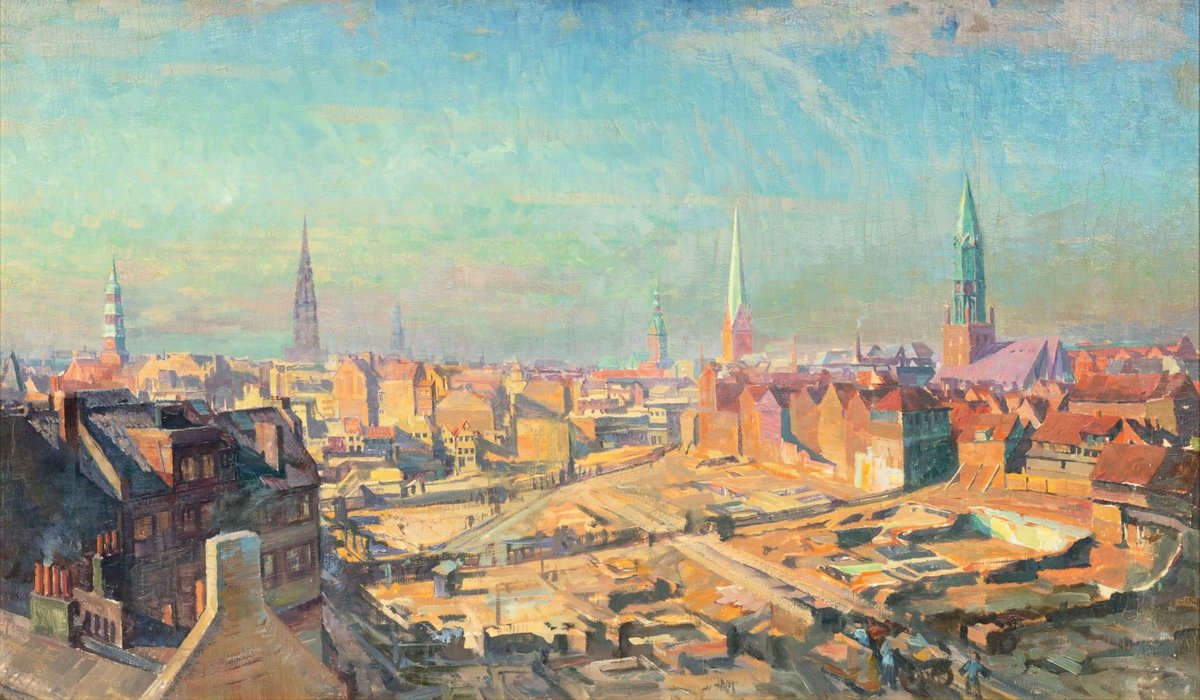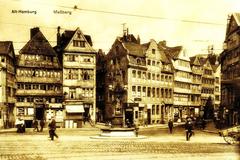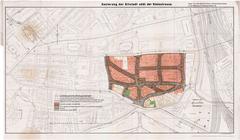
Kontorhaus District Hamburg: Complete Visiting Hours, Tickets, and Historical Sites Guide
Date: 14/06/2025
Introduction
The Kontorhaus District in Hamburg is an architectural and cultural landmark, recognized as a UNESCO World Heritage Site and celebrated for its exceptional Brick Expressionist style. Developed in the early 20th century to support Hamburg’s thriving port and trading industries, this district transformed a densely populated residential area into Europe’s first purpose-built office quarter. Today, the Kontorhaus District is a magnet for architecture enthusiasts, history lovers, and travelers eager to experience Hamburg’s commercial heritage and urban innovation.
This comprehensive guide covers everything you need to know for your visit: from opening hours and ticket information to architectural highlights, accessibility, top attractions, and practical advice. Whether you’re planning a short stop or a deep dive into Hamburg’s historic city center, use this resource to make the most of your experience (worldheritage.hamburg; Germany Travel Blog; UNESCO).
Table of Contents
- Overview of the Kontorhaus District
- Historical Context and Urban Development
- Architectural Styles and Influences
- Iconic Buildings: Chilehaus, Sprinkenhof, Meßberghof, Montanhof
- Urban Layout and Key Streets
- Decorative Features & Public Art
- Visiting Hours, Tickets, and Accessibility
- Getting There & Navigation Tips
- Guided Tours and Events
- Nearby Attractions
- Visitor Services & Sustainability
- FAQ
- Summary and Final Tips
- References
Overview of the Kontorhaus District
The Kontorhaus District is a pedestrian-friendly area in Hamburg’s southeastern Altstadt, easily accessible by public transport. Its ensemble of monumental office buildings, such as the Chilehaus, Sprinkenhof, Meßberghof, and Montanhof, showcase the creative use of clinker bricks, maritime motifs, and sculptural reliefs. The district’s wide boulevards, open courtyards, and decorative brickwork offer a distinctive ambiance—perfect for self-guided walks or in-depth architectural tours.
Historical Context and Urban Development
Originally a densely packed residential zone known as the “Gängeviertel,” the area underwent dramatic transformation following the Great Fire of 1842 and the cholera epidemic of 1892. By the 1920s, Hamburg’s leaders seized the opportunity for urban renewal, creating a dedicated office district to house the administrative needs of the city’s port and trade economy. Unlike the neighboring Speicherstadt, which focused on warehousing, the Kontorhaus District was exclusively commercial, with its layout deliberately designed to maximize light, air, and efficiency for office workers (worldheritage.hamburg).
Architectural Styles and Influences
Brick Expressionism
The hallmark of the district is Brick Expressionism—a regional architectural style that flourished in northern Germany during the interwar years. Defining features include:
- Clinker brick facades: Durable, richly colored bricks arranged in intricate patterns.
- Vertical emphasis: Tall pilasters, setbacks, and rhythmic window arrangements.
- Ornamentation: Sculpted brickwork, ceramic tiles, and maritime motifs referencing Hamburg’s port heritage.
Functionalism and Modernism
Alongside stylistic flourishes, the district’s buildings exemplify early Modernism and Functionalism: large windows, open floor plans, and internal courtyards ensured natural light and ventilation, a progressive approach for office buildings of the era.
Notable Architects
Visionaries like Fritz Höger, Johann Friedrich Höger, and Fritz Schumacher shaped the district, blending practical needs with aesthetic ambition to create a cohesive architectural icon.
Iconic Buildings
Chilehaus
The Chilehaus is the district’s crown jewel and an international symbol of Brick Expressionism. Designed by Fritz Höger (completed 1924), the building is famous for its sharp, ship-like prow and dramatic curves, echoing the maritime spirit of Hamburg. Made from nearly five million bricks, the Chilehaus stands ten stories high and features ornate geometric patterns and sculptural details. The lobby and courtyards are open to the public on weekdays (worldheritage.hamburg; UNESCO).
Sprinkenhof
Constructed between 1927 and 1943 by Hans and Oskar Gerson with Fritz Höger, the Sprinkenhof was once Europe’s largest office building. Its horseshoe-shaped layout, alternating light- and dark-brick bands, and ceramic reliefs depicting Hamburg’s commercial life make it a highlight of the district.
Meßberghof
Completed in 1924 by Hans and Oskar Gerson, Meßberghof introduced steel-frame construction to Hamburg, allowing for larger windows and more flexible office layouts. Its rhythmic brickwork and restrained ornamentation mark the evolution from traditional to modern.
Montanhof
Built between 1924 and 1926 by Distel and Grubitz, Montanhof’s vertical brick pilasters and decorative details reflect both the optimism of the Weimar Republic and the economic importance of Hamburg.
Urban Layout and Key Streets
- Burchardstraße: The district’s central thoroughfare, lined with Chilehaus, Sprinkenhof, and other major buildings. Wide sidewalks and uniform facades create an impressive streetscape.
- Steinstraße & Meßberg: Form the northern and eastern boundaries, offering a mix of historic and modern structures, shops, and cafes. Steinstraße is especially lively and connects easily to the Speicherstadt.
Decorative Features & Public Art
The Kontorhaus District is celebrated for its artistic brickwork, sculpted reliefs, and public art. Notable elements include:
- Geometric brick patterns on facades and in courtyards.
- Maritime and commercial motifs in ceramic tiles and sculptures—especially on Chilehaus (by Richard Kuöhl).
- Hidden details: Explore side alleys and courtyards for unique artworks and period ironwork.
Visiting Hours, Tickets, and Accessibility
- District Access: The Kontorhaus District is an open urban area accessible 24/7.
- Building Interiors: Public access to interiors (such as Chilehaus’s lobby and courtyards) is typically Monday to Friday, 9:00 AM to 6:00 PM. Shops and cafes generally open 10:00 AM to 6:00 PM.
- Tickets: No ticket is required for street or courtyard access. Guided tours and special exhibitions may require tickets (€10–€20 per person; bookable online or at tourist centers).
- Accessibility: Streets and public areas are flat and wheelchair-friendly. Many shops and cafes have step-free entry, though some historic interiors may have limited access. Public restrooms and seating are available.
Getting There & Navigation Tips
- By Public Transport: U-Bahn stations Meßberg (U1) and Steinstraße (U1), or Mönckebergstraße (U3) offer easy access.
- On Foot or by Bike: Centrally located, the district is walkable from Hamburg Hauptbahnhof and adjacent attractions. City bike rentals are widely available.
- By Car: Parking garages are nearby but limited—public transport is recommended (Hamburg Travel).
Navigation: The district is compact and well-signposted, with bilingual plaques and information boards.
Guided Tours and Events
- Guided Walking Tours: Available in multiple languages, these tours provide expert insights into the district’s history and architecture. Typical duration: 1–2 hours. Many tours also include the Speicherstadt (Germany Travel Blog).
- Self-Guided Options: Interactive apps and audio guides are available (e.g., Audiala app).
- Special Events: Open Monument Day (September) offers rare access to interiors. Seasonal illuminations add a festive atmosphere in winter.
Nearby Attractions
- Speicherstadt: Hamburg’s historic warehouse district—also UNESCO-listed—features museums, cafes, and scenic canals.
- Elbphilharmonie: The world-renowned concert hall is a short walk away, offering panoramic views and cultural events.
- Hamburg City Hall: A neo-Renaissance gem, easily reached on foot.
Visitor Services & Sustainability
- Tourist Information Centers: Located at Hamburg Hauptbahnhof and city center, providing maps, guides, and multilingual support.
- Wi-Fi & Hamburg CARD: Free Wi-Fi in many cafés; the Hamburg CARD offers discounts on public transport and attractions.
- Sustainability: As a UNESCO site, preservation is a priority. Respect all signage and avoid littering or graffiti (UNESCO).
Frequently Asked Questions (FAQ)
Q: What are the Kontorhaus District visiting hours?
A: The district is open 24/7; interiors and courtyards generally Monday to Friday, 9:00 AM–6:00 PM.
Q: Are tickets required?
A: No ticket is needed for general access. Guided tours and special exhibitions may require tickets.
Q: Is the district wheelchair accessible?
A: Yes, most public areas are accessible; some historic interiors may be limited.
Q: When is the best time to visit?
A: Late spring to early autumn for mild weather. Early mornings and evenings are quieter and ideal for photography.
Q: Are guided tours available?
A: Yes, in multiple languages, covering history and architecture.
Summary and Final Tips for Visiting
The Kontorhaus District is a living testament to Hamburg’s commercial ambition and architectural innovation. Its grand Brick Expressionist buildings, wide boulevards, and vibrant public spaces offer a unique window into the city’s past and present. For the best experience:
- Visit in spring or autumn for comfortable weather.
- Explore early or late in the day for fewer crowds and beautiful light.
- Combine your visit with adjacent attractions like Speicherstadt or the Elbphilharmonie.
- Use guided tours or interactive apps to deepen your knowledge.
- Respect preservation efforts and enjoy the district’s unique blend of history and modern urban life.
Stay updated on events and visitor information by downloading the Audiala app and following official Hamburg tourism channels (worldheritage.hamburg; UNESCO; Germany Travel Blog).
References
- Visiting the Kontorhaus District in Hamburg: History, Architecture & Visitor Guide, 2024 (worldheritage.hamburg)
- Visiting the Kontorhaus District Hamburg: Architectural Highlights, Hours & Tickets, 2024 (worldheritage.hamburg)
- Visiting the Kontorhaus District in Hamburg: Hours, Tickets & Top Attractions, 2024 (Germany Travel Blog)
- Kontorhaus District Visiting Hours, Tickets & Guide to Hamburg’s Historic Landmark, 2024 (Hamburg Travel)
- UNESCO World Heritage Centre: Kontorhaus District and Speicherstadt, 2024 (UNESCO)





















































































